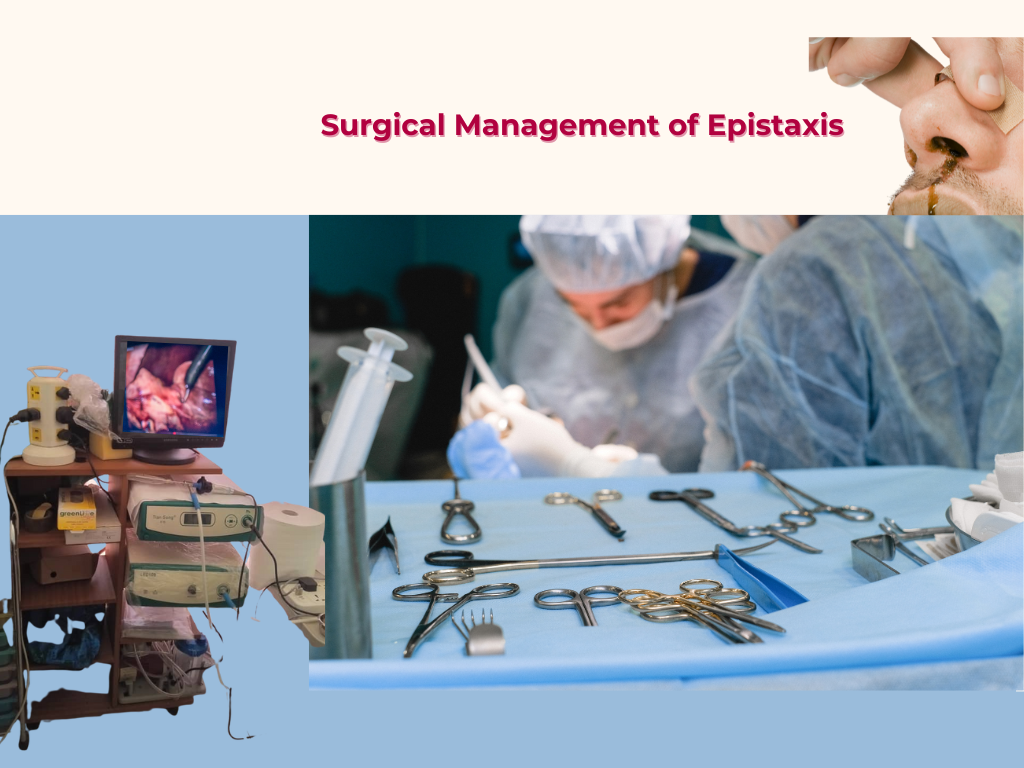
Overview
Epistaxis, or nosebleed, can be a challenging condition to manage, especially when it is severe or recurrent. Surgical management may be necessary when conservative measures fail to control the bleeding.
Indications for Surgical Management
-
1. Severe or recurrent bleeding
Bleeding that is difficult to control or recurs frequently.
-
2. Failed conservative managemen
When nasal packing, cauterization, or other conservative measures fail to control the bleeding.
-
3. Significant blood loss
When the bleeding is significant enough to cause hemodynamic instability.
Surgery
Surgical Options
-
1. Endoscopic sphenopalatine artery ligation (ESPAL)
A minimally invasive procedure that involves ligating the sphenopalatine artery to control bleeding.
-
2. Anterior ethmoidal artery ligation
Ligation of the anterior ethmoidal artery to control bleeding from the anterior nasal septum.
-
3. External carotid artery ligation
Ligation of the external carotid artery to control bleeding from the nasal cavity.
Step-by-Step Procedure
The specific steps of the procedure will depend on the surgical approach chosen. However, the general steps include:
-
1. Preparation
The patient is prepared for the procedure, and the nasal cavity is anesthetized.
-
2. Endoscopy
A nasal endoscope is used to visualize the nasal cavity and identify the source of bleeding.
-
3. Ligation of blood vessels
The blood vessels are ligated using clips, sutures, or other methods.
-
4. Cauterization
The bleeding site may be cauterized to ensure hemostasis.
Management
Postoperative Management
-
1. Nasal packing
Nasal packing may be used to support the nasal mucosa and prevent re-bleeding.
-
2. Pain management
Pain relief medication is prescribed to manage postoperative pain.
-
3. Follow-up
Regular follow-up appointments are necessary to monitor healing and remove any packing.
Complications
-
1. Re-bleeding
Bleeding can recur if the ligation is not successful or if there are other sources of bleeding.
-
2. Nasal septal perforation
Perforation of the nasal septum can occur if the mucosa is damaged during the procedure.
-
3. Infection
As with any surgical procedure, there is a risk of infection.
Surgical management of epistaxis is a effective option for controlling severe or recurrent bleeding that is not responsive to conservative measures. The choice of surgical procedure depends on the source of bleeding and the patient’s overall condition.
Want to Know More of
Nosebleeds (epistaxis) can be alarming, but most cases can be managed with simple first aid. Here’s what you need to know. . . . . . . . . . . . . . . . . . . . .
Share Post On:
Recent Posts
-
Nuggets of ORL-RHINOLOGY
-
Nuggets of Otorhinolaryngology-Basic sciences
-
Anatomy of the Muscles of the Soft Palate
-
Ethmoidal Arteries Ligation for Epistaxis
-
Submucous Cleft Palate (SMCP)
-
Approach to Ligation of the External Carotid Artery
-
Approach to Managing a 3-Year-Old Boy with a Foreign Body in the nasal cavity.
-
Approach to Managing a 3-Year-Old Boy with a Foreign Body impacted in the ear canal.
-
Endoscopic Sphenopalatine Artery Ligation (ESPAL) for Epistaxis
-
Surgical Management of Epistaxis
-
Technique of Incision and Drainage of Septal Hematoma/Septal Abscess
-
Upper Aerodigestive Tract Foreign Body Impaction
-
Incision and Drainage of Hematoma Auris
-
Rigid Bronchoscopy for Retrieval of Foreign Bodies in Children
-
Foreign Body Impaction in the Larynx, Trachea, and Bronchi
-
Leadership Position is a Tool, not a Trophy
-
Carcinoma of the Oropharynx
-
Peritonsillar Abscess
-
Ethics of Doctor-Patient Relationship
-
Doctor-Patient Relationship Case Scenarios
-
Asymmetrical Tonsils and Approach to Evaluation and Management
-
Nasal Polyposis
-
Rigid Oesophagoscopy and Complication
-
Anatomy of Oesophagus
-
Stridor, Snoring, Stertor And Wheezing: How They Compare
Categories
RELATED POSTS
Get in Touch
Read doctor-produced health and medical information written for you to make informed decisions about your health concerns.

